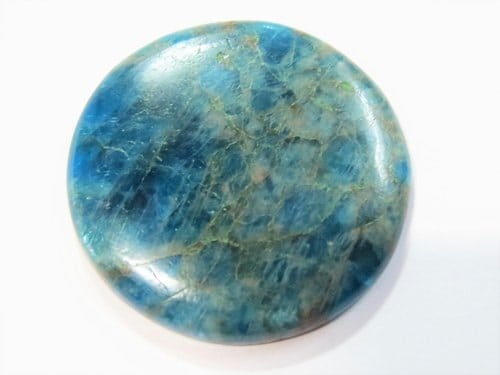
Apatite is a group of phosphate minerals.
This stone is produced in various shades and shapes. In the past it was often confused with other minerals such as aquamarine and amethyst.
Therefore, it was named apatite after “apate” which means “deceive, deceive” in Greek.
What is Apatite Gemstone:
Apatite is actually very familiar to us. This is because hydroxyapatite, a member of the apatite group, is a major component of our bones and teeth.
Therefore, artificial bones and artificial tooth roots are made from apatite. In addition, apatite is added to xylitol in gums that are used as an ingredient in toothpaste and are said to be good for teeth, and they are also added to sweets that claim calcium supplementation.
In addition, it has long been widely used as an important material in the medical and industrial world.
It is also used as an inner tube paint for fluorescent lamps, temperature sensors for electrical appliances, medical equipment, and as a chemical fertilizer because it contains a large amount of phosphorus.
It seems that apatite has been touted as a mineral that emits dozens of times more negative ions than tourmaline and started to be distributed as a gemstone.
How does Apatite Look:
There are many types of apatite, each with a very different color and appearance.
The most common gemstones are blue apatite, which has an opaque to transparent blue color, but there are many other gemstones such as green, yellow, gray, and colorless.
For example, some blue apatite is opaque and has crack-like crystal lines on its surface, while others look like transparent glass.
There are few gem-quality stones, but in some cases it looks like a transparent tourmaline or is polished to a beautiful cabochon with Cat’s Eye.
Benefits of Apatite:
Following are the benefits of aprtite:
- Strengthening of structure,
- promotion of action,
- smooth growth,
- filling of emotional energy,
- healing of mind and body
Healing effects of Apatite:
As explained in “Meaning of Power Stone”, there is a suggestion that it affects calcium absorption, so in the field of stone healing, it is reported that apatite is used for various symptoms related to bones, teeth and joints. there is.
However, these effects and benefits have not been proven in modern medicine.
Magical Effects of Apatite:
The central suggestion as a gemstone is “strengthening the structure”.
It is an image of supplementing the structural part, including the physical side, psychological side, and metaphysical side.
For example, as a healing stone, as mentioned above, it is said to affect the absorption of calcium, and it is said to be an appropriate stone for problems related to bones, teeth, joints, and associated movement and athletic ability. ..
In that sense, giving it to a growing child or putting it under a pillow to sleep will be a good amulet for good growth.
Of course, apatite works by itself, but at the same time, it seems to have a strong image of acting as a catalyst and promoting other actions. Therefore, when used in combination with other stones, it may promote the power of that stone.
On the psychological side, there is a theory that blue apatite has a positive effect on the psychological side. It is said to lift the depressed mind, fill it with emotional energy, open the mind to the outside world, stimulate the throat chakra and help communicate with others.
In that sense, it seems to be a suitable stone for those who tend to be depressed, those who tend to think things negatively, and those who tend to withdraw.
How to cleanse the Energy of Apatite:
There are many types of apatite, and their characteristics are slightly different, so it cannot be said unconditionally, but it is safe to avoid washing with water or sunbathing as it may cause fading. We recommend purification by crystal or by sound such as crystal tuner.
Apatite corresponds to which chakra:
Throat, chest
Directions corresponding to Apatite:
east
Properties of Apatite:
| Mineral name | Apatite (apatite) Apatite (apatite) |
|---|---|
| alias | — |
| Misnomer | Canadian emerald |
| Main production areas | Brazil, Mexico, Canada, India, Madagascar |
| Classification | Phosphate Minerals Apatite Group |
| Chemical composition | Ca 5 (PO 4 ) 3 F Fluorine, calcium, phosphorus, oxygen compounds |
| Crystal system | Hexagonal system |
| Crystal habit (shape) | Columnar, plate |
| Main shades | Navy blue, blue, light blue, green, yellowish green, gray, colorless |
| Streak color | White |
| hardness | Five |
| cleavage | None |
| specific gravity | 3.17-3.23 |
| Refractive index | 1.63 to 1.64 |
| Similar stone non-made | Parai Battle Marine, Aquamarine, Sapphire, Tourmaline, Emerald |
As mentioned in the section on the origin of characteristics and names, apatite comes in a variety of colors and is often mistaken for other minerals. Apatite with good coloring is a stone whose color is most similar to Paraiba tourmaline, which is synonymous with high-class tourmaline. Clear blue apatite resembles aquamarine, navy blue apatite resembles sapphire, and green apatite resembles green tourmaline or emerald.
As a mineral, it is widely produced all over the world. Apatite is actually the name of a mineral group, and each mineral in the group is often mixed. The most common is “fluorine apatite”, which is calcium phosphate plus fluorine.
Apatite is originally a colorless mineral, but it can be colored in various colors depending on the inclusions such as trace amounts of manganese. Some types have cat’s eyes.